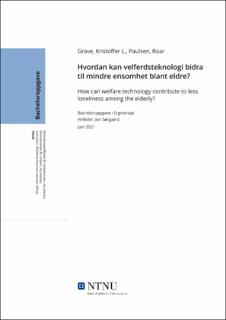| dc.contributor.advisor | Sørgaard, Jon | |
| dc.contributor.author | Grave, Kristoffer L. | |
| dc.contributor.author | Paulsen, Roar | |
| dc.date.accessioned | 2021-09-25T16:31:38Z | |
| dc.date.available | 2021-09-25T16:31:38Z | |
| dc.date.issued | 2021 | |
| dc.identifier | no.ntnu:inspera:82578383:84892048 | |
| dc.identifier.uri | https://hdl.handle.net/11250/2783257 | |
| dc.description.abstract | Hensikt
Hensikten med dette litteraturstudiet er å belyse hvordan kan velferdsteknologi bidra til mindre ensomhet blant eldre.
Metode
Scoping review ble benyttet for å få en oversikt over litteraturen fra temaet velferdsteknologi. Fra Oria, Scopus, Google scoolar og Idunn ble det valgt ut syv artikler. For å belyse problemstillingen ble disse artiklene benyttet samt to ergoterapeutiske teorier.
Resultat
Funnene viser at bruken av velferdsteknologi og digitale kommunikasjonsmetoder kan bidra til en følelse av økt sosial deltakelse. Derimot er mangel på motivasjon og kunnskap på bruk av verktøy en hindring ved implementering av tiltak. Også en mangel på studier innenfor bruk av digitale kommunikasjonshjelpemidler bidrar til utydelige resultater.
Konklusjon
Konklusjonen vår er at dersom teknologien skal bidra til mindre ensomhet blant eldre krever det god kunnskap, opplæring og løsninger. Dette vil også sannsynligvis også bidra til økt motivasjon da både hos bruker og ansatte. Velferdsteknologi er i stadig utvikling og nye løsninger kommer fortløpende. Da neste generasjon blir eldre kommer også teknologi til å bli mer vanlig da dagens generasjon er mer komfortabel med teknologi. | |
| dc.description.abstract | Purpose
The purpose of this literature study is to shed light on how welfare technology can contribute to less loneliness among the elderly.
Method
Scoping review was used to get an overview of the literature from the topic of welfare technology. From Oria, Scopus, Google scoolar and Idunn, seven articles were selected. To shed light on the research question, these articles were used and two theories in occupational therapy.
Result
The findings show that the use of welfare technology and digital communication methods can contribute to a sense of increased social participation. On the other hand, a lack of motivation and knowledge on the use of tools is an obstacle when implementing measures. A lack of studies in the use of digital communication aids also contributes to unclear results.
Conclusion
Our conclusion is that if the technology is to contribute to less loneliness among the elderly, it requires good knowledge, training and solutions. This will probably also contribute to increased motivation then both among users and employees. Welfare technology is constantly evolving, and new solutions are coming continuously. As the next generation gets older, technology will also become more common as the current generation is more comfortable with technology. | |
| dc.language | nob | |
| dc.publisher | NTNU | |
| dc.title | Hvordan kan velferdsteknologiske løsninger bidra til økt selvstendighet i ADL for hjemmeboende eldre? | |
| dc.type | Bachelor thesis | |
